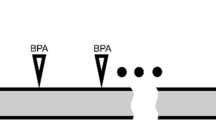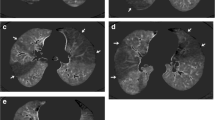Abstract
Objectives
Lung perfusion blood volume (PBV) using dual-energy computed tomography has recently become an accepted technique for diagnosing pulmonary thromboembolism. We evaluated the correlation among lung PBV, single-photon emission computed tomography (SPECT) and catheter pulmonary angiography images in patients with chronic thromboembolic pulmonary hypertension (CTEPH) before and after balloon pulmonary angioplasty (BPA).
Methods
In total, 17 patients and 57 sessions were evaluated with the three modalities. Segmental lung perfusion and its improvement in lung PBV and SPECT were compared with catheter pulmonary angiography as the reference standard before and after BPA.
Results
The sensitivity for detecting segmental perfusion defects using SPECT and lung PBV was 85% and 92%, the specificity was 99% and 99%, the accuracy was 92% and 95%, the positive predictive value was 99% and 99%, and the negative predictive value was 88% and 93%. The sensitivity for detecting segmental perfusion improvement using SPECT and lung PBV was 61% and 69%, the specificity was 75% and 83%, the accuracy was 62% and 70%, the positive predictive value was 97% and 98%, and the negative predictive value was 12% and 16%.
Conclusions
Lung PBV is a useful technique for evaluation of segmental lung perfusion and its improvement in patients with CTEPH.
Key Points
• BPA is a new treatment for patients with CTEPH.
• Lung PBV images may be more sensitive for pulmonary blood flow.
• The current work demonstrates that Lung PBV images are useful in evaluating patients with CTEPH.
• The current work demonstrates that Lung PBV is useful in gauging the treatment effect of BPA.



Similar content being viewed by others
Abbreviations
- BPA:
-
Balloon pulmonary angioplasty
- CTEPH:
-
Chronic thromboembolic pulmonary hypertension
- PBV:
-
Perfusion blood volume
- PE:
-
Pulmonary thromboembolism
References
Fuld MK, Halaweish AF, Haynes SE et al (2013) Pulmonary perfused blood volume with dual-energy CT as surrogate for pulmonary perfusion assessed with dynamic multidetector CT. Radiology 267:747–756
Thieme SF, Becker CR, Hacker M et al (2008) Dual energy CT for the assessment of lung perfusion-correlation to scintigraphy. Eur J Radiol 68:369–374
Nakazawa T, Watanabe Y, Hori Y et al (2011) Lung perfused blood images with dual-energy computed tomography for chronic thromboembolic pulmonary hypertension: correlation to scintigraphy with single-photon emission computed tomography. J Comput Assist Tomogr 35:590–595
Piazza G, Goldhaber SZ (2011) Chronic thromboembolic pulmonary hypertension. N Engl J Med 364:351–360
Voorburg JA, Cats VM, Buis B et al (1968) Balloon angioplasty in the treatment of pulmonary hypertension caused by pulmonary embolism. Chest 94:1249–1253
Maruoka Y, Nagao M, Baba S et al (2017) Three-dimensional fractal analysis of 99mTc-MAA SPECT images in chronic thromboembolic pulmonary hypertension for evaluation of response to balloon pulmonary angioplasty: association with pulmonary arterial pressure. Nucl Med Commun 38:480–486
Maschke SK, Renne J, Werncke T et al (2017) Chronic thromboembolic pulmonary hypertension: evaluation of 2D-perfusion angiography in patients who undergo balloon pulmonary angioplasty. Eur Radiol 27:4264–4270
Tamura M, Yamada Y, Kawakami T et al (2017) Diagnostic accuracy of lung subtraction iodine mapping CT for the evaluation of pulmonary perfusion in patients with chronic thromboembolic pulmonary hypertension: correlation with perfusion SPECT/CT. Int J Cardiol 243:538–543
Iwase T, Nagaya N, Ando M et al (2001) Acute and chronic effects of surgical thromboendarterectomy on exercise capacity and ventilatory efficiency in patients with chronic thromboembolic pulmonary hypertension. Heart 86:188–192
Manabe H, Nakatani S, Sugawara M et al (2007) Different time course of changes in tricuspid regurgitant pressure gradient and pulmonary artery flow acceleration after pulmonary thromboendarterectomy: implications for discordant recovery of pulmonary artery pressure and compliance. Circ J 71:1771–1775
Fleiss JL, Levin B, Paik MC (1981) Statistical methods for rates and proportions, 2nd edn. Wiley, New York, pp 14–15
Renard B, Remy-Jardin M, Santangelo T et al (2011) Dual-energy CT angiography of chronic thromboembolic disease: can it help recognize links between the severity of pulmonary arterial obstruction and perfusion defects? Eur J Radiol 79:467–472
Heinrich M, Uder M, Tscholl D et al (2005) CT scan findings in chronic thromboembolic pulmonary hypertension. Chest 127:1606–1613
Kauczor H-U, Schwickert HC, Mayer E et al (1994) Spiral CT of bronchial arteries in chronic thromboembolism. J Comput Assist Tomogr 18:855–861
Remy-Jardin M, Duhamel A, Deken V (2005) Systemic collateral supply in patients with chronic thromboembolic and primary pulmonary hypertension: assessment with multi-detector row helical CT angiography. Radiology 235:274–281
Orell SR, Hultgren S (1966) Anastomoses between bronchial and pulmonary arteries in pulmonary thromboembolic disease. Acta Pathol Microbiol Scand 67:322–328
Cabrol C, Cabrol A, Acar J et al (1978) Surgical correlation of chronic postembolic obstructions of the pulmonary arteries. J Thorac Cardiovasc Surg 76:620–628
Mills SR, Jackson DC, Sullivan DC et al (1980) Angiographic evaluation of chronic pulmonary embolism. Radiology 136:301–308
de Broucker T, Pontana F, Santangelo T et al (2012) Single- and dual-source chest CT protocols: levels of radiation dose in routine clinical practice. Diagn Interv Imaging 93:852–858
Ho LM, Yoshizumi TT, Hurwitz LM et al (2009) Dual energy versus single energy MDCT: measurement of radiation dose using adult abdominal imaging protocols. Acad Radiol 16:1400–1407
Ohana M, Labani A, Jeung MY et al (2015) Iterative reconstruction in single source dual-energy CT pulmonary angiography: Is it sufficient to achieve a radiation dose as low as state-of-the-art single-energy CTPA? Eur J Radiol 84:2314–2320
Acknowledgements
We thank Angela Morben, DVM, ELS, from Edanz Group (www.edanzediting.com/ac) for editing a draft of this manuscript.
Funding
This work was supported by JSPS KAKENHI Grant Numbers 15K09894, 24591776, and 26870436.
Author information
Authors and Affiliations
Corresponding author
Ethics declarations
Guarantor
The scientific guarantor of this publication is Eijyun Sueyoshi.
Conflict of interest
The authors of this manuscript declare no relationships with any companies, whose products or services may be related to the subject matter of the article.
Statistics and biometry
No complex statistical methods were necessary for this paper.
Informed consent
Written informed consent was waived by the institutional review board because this study was retrospective.
Ethical approval
Institutional review board approval was obtained.
Methodology
• retrospective
• case-control study
• performed at one institution
Rights and permissions
About this article
Cite this article
Koike, H., Sueyoshi, E., Sakamoto, I. et al. Comparative clinical and predictive value of lung perfusion blood volume CT, lung perfusion SPECT and catheter pulmonary angiography images in patients with chronic thromboembolic pulmonary hypertension before and after balloon pulmonary angioplasty. Eur Radiol 28, 5091–5099 (2018). https://doi.org/10.1007/s00330-018-5501-4
Received:
Revised:
Accepted:
Published:
Issue Date:
DOI: https://doi.org/10.1007/s00330-018-5501-4




